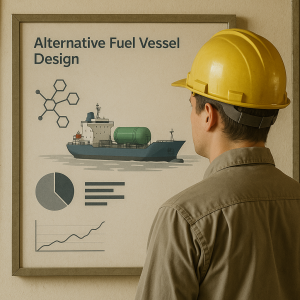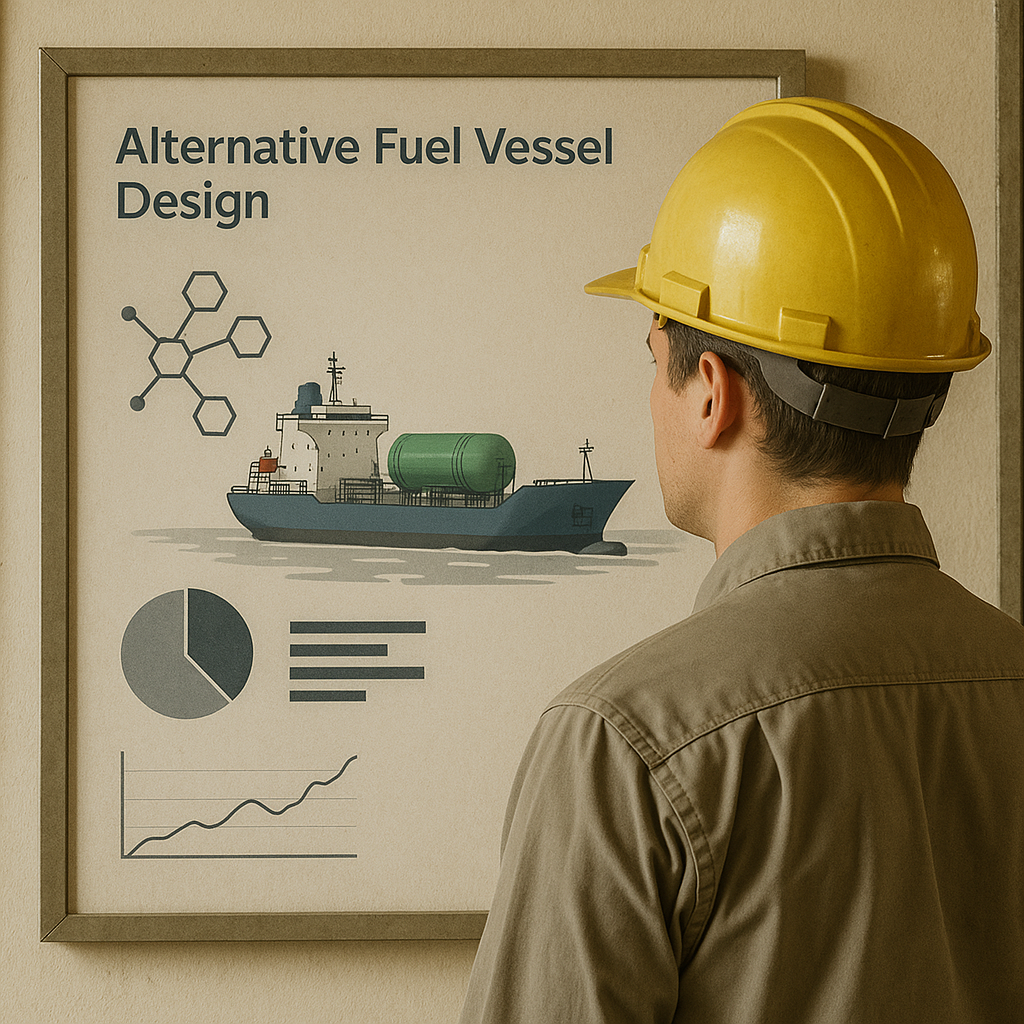Discover how Risk-Based Alternative Technology (RBAT) is shaping the design of next-generation fuel vessels. Learn how shipyards and regulators work together to deliver safe, sustainable ships from drawing board to deployment.

Why RBAT Matters in Modern Maritime Vessel Design
As the global maritime industry steers toward net-zero emissions, traditional rules and frameworks often fall short of addressing the complexities of alternative marine fuels. From hydrogen to ammonia, and from methanol to battery-electric hybrids, new fuel systems introduce unprecedented design challenges and safety considerations. Yet the urgency of climate action means we can’t wait for every standard to be fully written before building the ships of tomorrow.
This is where Risk-Based Alternative Technology (RBAT) comes in. RBAT allows shipyards, classification societies, and owners to bypass prescriptive rules—when justified by safety assessments—in favor of alternative designs that achieve equivalent or greater safety outcomes. Rooted in the IMO’s IGF Code (Part A-1) and supported by class societies like DNV, Lloyd’s Register, ClassNK, and Bureau Veritas, RBAT has become the bridge between ambition and regulation.
And its value is clearest at the beginning: at the ship design and construction phase. From the first 3D CAD models to dock trials, RBAT is now integral to turning bold fuel innovations into seaworthy, class-approved vessels.
–
Understanding RBAT in the Ship Design Lifecycle
The application of RBAT begins even before a ship is built. Its inclusion starts as early as the concept design phase, where feasibility and safety assessments shape critical decisions like fuel tank location, ventilation zones, and engine configuration.
RBAT Phases in the Design-to-Delivery Pipeline:
- Preliminary Design and Feasibility
- Fuel type selection (hydrogen, ammonia, methanol, LNG, etc.)
- Material compatibility and thermal stress simulations
- Preliminary Hazard Identification (HAZID)
- Detailed Design and Risk Assessment
- Full Quantitative Risk Assessment (QRA)
- System-level Failure Mode and Effects Analysis (FMEA)
- Ventilation, segregation, and fire suppression modeling
- Approval-in-Principle (AiP) via RBAT
- Submitted to classification societies for concept validation
- Input from Flag States begins
- Construction and Factory Acceptance Testing (FAT)
- Class oversight during system integration
- Testing for gas detection systems, ESD logic, and BOG management
- Sea Trials and Final Certification
- Emergency scenario testing (e.g., leak simulation, flame spread)
- Crew familiarization and STCW-compliant training
- Final sign-off with Class and Flag coordination
This process allows innovation to flourish while upholding safety, with feedback loops that often lead to new class notations or amendments to existing maritime codes.
–
Key Developments Driving RBAT in Alternative Fuel Shipbuilding
Hydrogen and Ammonia Vessels
Hydrogen-powered ships, like MF Hydra in Norway, use RBAT to address lack of codified hydrogen rules in SOLAS and the IGF Code. Similarly, ammonia is being trialled under RBAT pathways due to its toxicity and lack of combustion maturity.
Recent RBAT-supported developments:
- Suiso Frontier, the world’s first liquid hydrogen carrier, gained Flag State and Class approval via QRA.
- Samsung Heavy Industries and DNV developed ammonia-ready tankers using RBAT to model blast zones and crew exposure limits.
Methanol-Fueled Commercial Fleets
Maersk’s series of methanol dual-fuel ships integrated RBAT into:
- Ventilation and fuel line routing
- Redundant fire suppression near methanol tanks
- Bunkering simulation tests
This allowed early methanol use ahead of IMO’s prescriptive methanol code (MSC.1/Circ.1621).
Battery-Electric and Hybrid Ships
Large electric ferries like Ellen in Denmark and MS Ampere in Norway are pushing battery capacity and management systems into uncharted waters. RBAT was used to:
- Assess thermal runaway risk
- Validate high-voltage isolation systems
- Justify containerized battery room designs
RBAT has also been central to gaining Approval in Principle (AiP) for onboard battery fire-fighting systems.
Onboard Carbon Capture Systems (CCS)
Systems designed by Wärtsilä and Alfa Laval integrate CCS units on ocean-going vessels. As these are not yet standardized, RBAT was necessary for:
- Evaluating heat management under extreme exhaust conditions
- Establishing gas tightness boundaries
- Modeling blast relief panels
–
Challenges and Solutions in Integrating RBAT into Shipbuilding
Design Complexity and Cost
Integrating RBAT means added front-loaded effort in risk modeling and multi-party coordination. Early design phases may take months longer.
Solution: Digital twin platforms (e.g., DNV MarOS) are accelerating hazard simulation. Class societies now offer streamlined QRA packages and VR-based design audits.
Gaps Between Flag and Class Acceptance
Not all Flag States interpret RBAT outcomes the same way, leading to uncertainty in cross-border acceptance.
Solution: The IMO GISIS and joint EMSA-Class initiatives (as seen in the EU’s Horizon Europe-funded SEANERGY project) aim to harmonize RBAT-based approval processes.
Crew Competency and Familiarity
RBAT-derived systems may require operation outside traditional marine training.
Solution: Integration of RBAT-based equipment into IMO Model Courses, STCW updates, and in-house training programs, including VR simulations from The Nautical Institute.
–
Case Studies: RBAT Across the Design Chain
Case 1: MF Hydra – Hydrogen-Powered Ferry (Norway)
- RBAT used to approve high-pressure hydrogen storage and fuel cell compartments.
- Fire scenarios, leak dispersion modeling, and crew drills formed part of final approval.
- Built by Westcon Yard, classed by DNV.
Case 2: Maersk’s Methanol-Fueled Fleet
- Shipyards worked with MAN Energy Solutions and ABS to incorporate RBAT assessments.
- QRA models focused on engine room fire protection and bunkering event chains.
- Enabled early delivery before formal IGF Code amendments.
Case 3: Samskip Battery-Powered Container Ship
- Designed by NAVAL DC and built in the Netherlands, the ship includes modular battery packs.
- RBAT validated isolation, power management, and hotbox containment in partnership with BV.
- Received co-funding via the European Innovation Council (EIC).
–
Future Outlook: RBAT’s Role in Shaping Shipyards of Tomorrow
RBAT isn’t just a workaround—it’s a new standard for enabling safety through innovation. As shipyards design more zero-emission vessels, RBAT will:
- Shorten time to market for new fuel vessels
- Reduce uncertainty in Flag/Port acceptance
- Encourage Class to co-develop evolving safety notations
Expect developments such as:
- Shared RBAT scenario libraries for faster QRA modeling
- AI-enhanced risk assessment tools using ship design datasets
- IMO-backed training frameworks for RBAT literacy across design teams
RBAT will likely become a cornerstone of sustainable naval architecture, influencing how academic programs, shipyards, and classification societies teach and apply maritime design safety.
–
FAQ: RBAT in Alternative Fuel Ship Design
What is RBAT in ship design? RBAT (Risk-Based Alternative Technology) allows ship designs that differ from prescriptive rules, if they achieve equivalent safety via risk assessment.
Is RBAT only for new ships? No, it applies to both newbuilds and retrofits, including onboard fuel conversion systems.
What fuels are commonly involved? Hydrogen, ammonia, methanol, LNG, and emerging options like battery-electric and carbon capture systems.
Who approves RBAT designs? Classification societies (e.g., DNV, ABS) and Flag States, usually in coordination.
How long does the RBAT process take? Depending on complexity, 6–18 months from concept to final approval.
Are there RBAT training programs for shipbuilders? Yes. Institutions like Massachusetts Maritime Academy, IMAREST, and WISTA now incorporate RBAT scenarios in ship design coursework.
–
Conclusion: Building Safer, Smarter Ships with RBAT
The shift to alternative fuels is more than a change in energy—it’s a transformation in how ships are designed, built, and operated. RBAT offers a proven path through the uncertainty, helping shipyards turn visionary designs into seaworthy realities.
From hydrogen-powered ferries to methanol giants, battery-electric container ships to ammonia-ready tankers, RBAT enables the maritime industry to sail ahead without waiting for rulebooks to catch up.
For maritime professionals, shipowners, regulators, and students alike, understanding RBAT is now essential to navigating the frontier of sustainable shipping.
References
- IMO IGF Code – Part A-1 Provisions
- DNV RBAT Guidelines and MarOS Tool
- ABS Methanol Vessel Guidelines
- EMSA Study on Maritime Innovation and Safety
- Samskip Battery Ship Announcement
- The Nautical Institute – RBAT Training Resources
- Maersk Methanol Fleet Project
- ClassNK Guidelines for Hydrogen and Fuel Cells
- IMO GISIS Platform
- SEANERGY – Horizon Europe Maritime Decarbonisation
- Wärtsilä CCS and Alternative Fuel Projects

